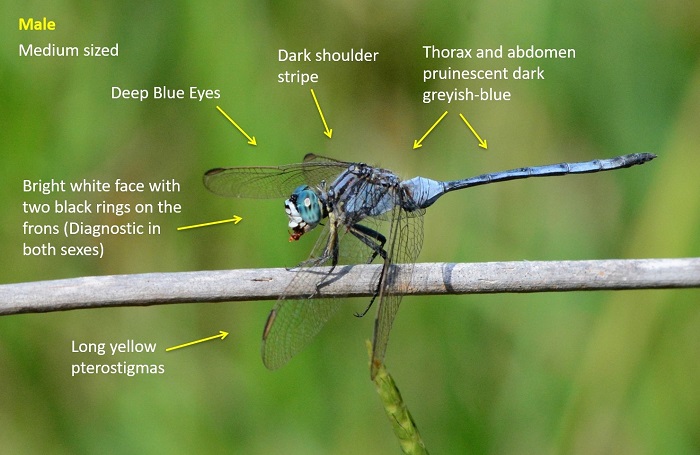The photo above (by Alan Manson) can be viewed in OdonataMAP here.
Find this species in the FBIS database (Freshwater Biodiversity Information System) here.
Family Libellulidae
Orthetrum icteromelas – SPECTACLED SKIMMER
Identification
Medium sized
Length up to 45mm; Wingspan attains 64mm.
Both sexes are distinctive and easily identified. Adult males have a darker blue-grey colouration when compared to many other Orthetrum males.
Males also show two diagnostic black rings (spectacles) on the white frons. This trait is also present in immature males and females. Note that the ‘spectacles’ may be less obvious in females. Orthetrum abbotti (Little Skimmer) also has ‘spectacles’ on the frons, but the markings are less distinct and the frons is greyish rather than clear white. Orthetrum abbotti is also noticeably smaller.
Immature males and females are boldly patterned in black and yellow. They also show diagnostic, broad black markings along the top of the abdomen.
Click here for more details on identification.

Near Kosi Bay, KwaZulu-Natal
Photo by Ryan Tippett

Near Himeville, KwaZulu-Natal
Photo by Corné Rautenbach
Habitat
Inhabits standing waters, especially swamps, marshes and floodplains. Favours sites with shallow water and a rich growth of emergent grasses, sedges and forbs. Sometimes found at man-made dams that provide suitable habitat.

Photo by Ryan Tippett
Behaviour
Perches prominently on grass stems. Fairly tame and confiding. Takes short flights to hunt prey, often returning to the same perch. Spectacled Skimmers are voracious hunters and frequently take large prey, including other dragonflies as large as themselves. Males and females are found in the same areas.
Status and Conservation
Orthetrum icteromelas is somewhat scarce and localised. It is listed as of Least Concern in the IUCN Red List of Threatened Species. The Spectacled Skimmer has benefited from small man-made impoundments on rivers that offer suitable marshy habitat. Its natural marsh habitat is under threat in some areas due to expanding agriculture.
Distribution
Found throughout most of sub-Saharan Africa and Madagascar. Absent only from the arid regions of NE Africa and the dry SW parts of South Africa and Namibia. It has a disjunct distribution in South Africa.
Below is a map showing the distribution of records for Spectacled Skimmer in the OdonataMAP database as at February 2020.

The next map below is an imputed map, produced by an interpolation algorithm, which attempts to generate a full distribution map from the partial information in the map above. This map will be improved by the submission of records to the OdonataMAP section of the Virtual Museum.


Ultimately, we will produce a series of maps for all the odonata species in the region. The current algorithm is a new algorithm. The objective is mainly to produce “smoothed” maps that could go into a field guide for odonata. This basic version of the algorithm (as mapped above) does not make use of “explanatory variables” (e.g. altitude, terrain roughness, presence of freshwater — we will be producing maps that take these variables into account soon). Currently, it only makes use of the OdonataMAP records for the species being mapped, as well as all the other records of all other species. The basic maps are “optimistic” and will generally show ranges to be larger than what they probably are.
These maps use the data in the OdonataMAP section of the Virtual Museum, and also the database assembled by the previous JRS funded project, which was led by Professor Michael Samways and Dr KD Dijkstra.

